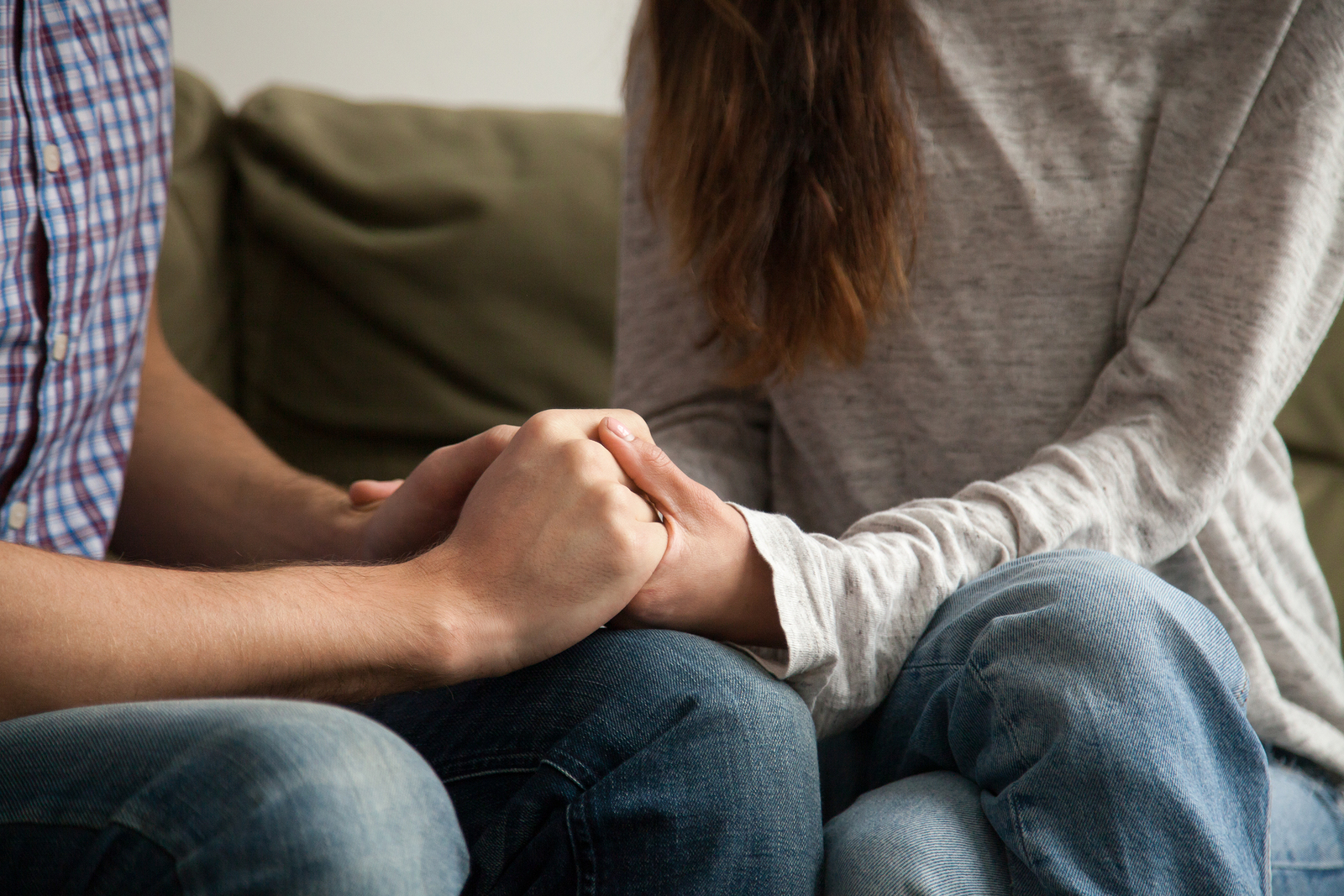
by Ryan Smith | Mar 28, 2019
Real people. Real
circumstances. Real prayers.
That’s what I see
more and more as I read the Scriptures.
Real people
struggling to understand and trust a holy God.
Real
circumstances in which people try to navigate a broken and sin-soaked world.
Real prayers of
those turning to God for truth and hope.
Imagine a person
gathered each week with your church family. They are experiencing thoughts and
feelings they don’t know what to do with. They don’t see themselves fitting the
general gender stereotypes placed before them. They are confused and praying to
God. Would they know how to engage you or your church family?
Imagine a person
walking through your church’s doors for the first time. They’ve been invited by
a friend, but aren’t sure what to expect. They have walls built up and have
heard that Christians don’t like people like them. They’ve heard God doesn’t
like people like them. They are afraid; perhaps defensive. Would they know how
to engage you or your church family?
The transgender
movement has been one of the most volatile social movements of recent decades.
The church can easily feel ill-equipped, unprepared and unsure about how to
handle our society’s broad acceptance of, and encouragement toward, a
genderless or gender-fluid world.
This is the
second article in a short series about transgenderism and the church. In the
first article, “The
Church and the Transgender Moment,” I attempted to provide definitions.
Simply knowing what our transgender neighbors are thinking, experiencing and
saying can hopefully help us enter the conversation with the mind of Christ.
In this article,
I ask us as the church to evaluate how we can best love and walk in the Gospel
with our neighbors outside and inside the church who may be struggling with
transgenderism.
What Our Transgender Neighbors Need
What our
transgender neighbors need is the same thing the pastor, the liar, the small
group leader, the addict and the suburban soccer mom need: The Gospel of Jesus
Christ. Transgender people don’t need a different gospel. Like all of us in a
broken and fallen world, they need to turn from the kingdom of self, surrender
to Christ as King and trust Him daily in new resurrected life.
The good news for
the church is that we know the Gospel. We have the Bible. We may not have a lot
of training or a gender-studies degree from Harvard, but we can introduce
people to Jesus. Could it be difficult walking through the Bible, wrestling
with big questions and sharing the love of Jesus with a transgender neighbor?
Absolutely. Frankly, it’s hard for me to walk through the Bible, wrestle with
big questions and share the love of Jesus with myself! Ease is not our Gospel
paradigm.
A hopefully
helpful paradigm for our churches to adopt in engaging our transgender
neighbors is simply this: be clear about the whole Gospel. As many have done
before, we can attempt to explain the Gospel clearly as Creation, Fall and
Restoration.
Creation
When we speak of
creation, it’s important we talk not only about God as Creator, but also what
He has created. In speaking of His creation, it is vital we not only address
the “no” or boundaries, but the “yes” and what protection, provision and
flourishing those boundaries provide.
Statistically, 80-85
percent of children or youth who identify as transgender will ultimately end up
identifying with their birth sex. Gender confusion at this stage often can
result from one not relating to gender molds placed before them. To engage a
sexually questioning culture, we must affirm and uphold God’s design of male
and female, but also ensure we are providing biblical definitions—not re-applying cultural definitions. It is true a lot of men like sports, the
outdoors and the combination of meat with fire. There is nothing wrong with
that. However, that is not biblical manhood.
We must be
willing to ask: does our church have room for the man who doesn’t like sports
or the woman who does? Do we clearly define, emphasize and celebrate the
biblical man who faithfully takes the initiative in leading his home toward
Christ, yet prefers an art brush to a rifle? Do our youth understand that what
they enjoy does not define their gender, but can be used within their gender to
create a wonderful spectrum of people God calls and uses in obedience to Him?
Are we a church
that affirms and celebrates the single adult the way Paul celebrates them in
his first letter to the Corinthians? The church must be the champion of God’s
gender definitions and uphold the roles of biblical manhood and womanhood, but
not first filter them through cultural ideologies. We must teach on difficult
passages and champion those who follow Christ well in marriage as well as
singleness.
Fall
While this is
reductionistic, we could say the God of Genesis 1 created the genders of
Genesis 2, and they were broken in Genesis 3 where we live today. It is
important that we emphasize all three aspects of this narrative. We live in a
world of distortion—particularly sexual distortion. Even some of the most
instrumentally recognized people in Scripture displayed sexual brokenness—David
committed adultery and let his eyes go where they shouldn’t. Rahab was a
prostitute. Judah slept with his daughter-in-law whom he thought was a
prostitute (not to mention Noah, Solomon, and others).
One of the
biggest questions for people with gender dysphoria in our midst is, “Why would God make me this way if it is
wrong?” Upholding what God created in Genesis 1-2 reminds us how we are
created, but pointing to Genesis 3 helps us remember how we are broken. As the
church, we must be those who embrace, sympathize and empathize with all who are
broken and come together under the cross of Christ. The phrase, “It’s okay not
to be okay, but it’s not okay to stay that way” must be the church’s refrain as
we all come to grips with our condition.
Restoration
While we are all
broken images—holding innate distortions of what we are meant to be—we must
continually remind each other that the story doesn’t end at Genesis 3, but
calls us forward to Revelation 21-22, when all things are restored and made new
for those in Christ.
In the meantime,
just as Paul exhorted the Corinthians in relation to their sin, sexual
brokenness and dysphoria, we must also exclaim, “And such were some of you. But you were washed, you were sanctified,
you were justified in the name of the Lord Jesus Christ and by the Spirit of
our God” (1 Cor. 6:11). God may
never change those desires, but God certainly is in the business of changing
lives to be used for His glory and our good in the church.
Our transgender
neighbors need to know we are all tempted by innate desires that run contrary
to truth. It is not those desires, but what we do with them that makes us who
we are. The Bible invites us to cast off our old way of life, lay down our
desires at the feet of Jesus and walk in resurrected obedience to Him. When one
comes to Christ, God doesn’t remove them from the sinful world. He does enable
them, however, to recognize this world is not our home. One day, God will
restore us and make all things new. We can all look forward to that day
together.
Acts chapter 8
records one of the first conversions to Christianity. Interestingly, this man
was a eunuch—one who had been physically altered to embrace a dis-gendered
existence—someone who might be referred to today by the transgender definition,
“Gender Queer.” The Holy Spirit led Philip directly to him. What was of
interest was not his sexual status or capabilities, but his question—“What does this Scripture mean, and who is
the Messiah?” He was a real person in real circumstances with real prayers.
Let those of us
in Christ remember that we share the same baptismal waters that called to that
eunuch. We share the same confession of Christ’s lordship and look forward to a
renewed day, secured by the resurrection of Jesus. The Gospel extends hope,
joy, family and redemption beyond what often fits the definitions we are used
to. Let us do the same.

by Ryan Smith | Mar 21, 2019
In a recent interview, Grammy award winning
singer/songwriter Sam Smith revealed he considers himself to be non-binary
sexually and has considered a sex change. He stated, “Maybe I’m not a man, maybe I’m not a woman, maybe I’m just me.”
What is your church prepared to do with this?
What Sam is offering is an embodiment of our cultural
transgender moment. The church has largely been at arm’s length from
transgenderism. Many would assume, or prefer, transgendered ideologies to be
outside the purview of the church. A problematic question, however, presents
itself: Is transgenderism outside the
purview of the Gospel?
This topic can be extremely uncomfortable for many within
the church. Discussing definitions and asking difficult questions about
transgenderism must come from within the church and be to the glory of God and
for the edification of the church. To this end, I intend to offer a short
series of articles outlining our transgender moment and how the church can
respond with Biblical faithfulness, Gospel compassion and an offering of hope
and truth through Jesus Christ. This is part one of the series and hopefully offers a helpful
definition of transgenderism.
What is Transgenderism?
The native tongue of gender across religious and cultural
boundaries for millennia has been a language of male and female distinction.
While this division has adopted various forms and expressions, the idea that
there are boys, girls and differences between the two, has been the dominant
opinion and observation. However, a new language is presenting itself whose
echoes and accents are becoming more prevalent in our common dialogue –
unbridled by distinctions deemed “traditional.”
Transgenderism is a
term many Christians have heard, but could likely not accurately define.
Basically, transgenderism is expressed when one feels one’s biological sex and
gender are incongruent. Transgender activist Chaz Bono explains the concept and
belief: “There’s a gender in your brain and a gender in your body. For 99
percent of people, those things are in alignment. For transgender people,
they’re mismatched. That’s all it is. It’s not complicated, it’s not neurosis.
It’s a mix-up. It’s a birth defect, like a cleft palate.”
Historically, one’s sex and gender have been identified at,
or before, birth based on one’s chromosomes and anatomy. However, this
biological identification of gender, in some cases, can conflict with one’s
inner feelings of being male, female, neither or both. This conflict is known
as gender dysphoria. Studies suggest
that between 1 in 10,000 and 1 in 13,000 males and between 1 in 20,000 and 1 in
34,000 females identify with this condition.
A primary contention of transgender advocates is that gender
is in the mind, not the body. Whereas one’s bodily sex may be determined by
biology, transgender individuals believe thoughts and feelings determine one’s
gender. According to a 2016 statement from the American College of
Pediatricians, “No one is born with a gender. Everyone is born with a
biological sex. Gender (an awareness and sense of oneself as male or female) is
a sociological and psychological concept, not an objective biological
one.”
A second assertion of the transgender community is that
gender is fluid. Since individuals may fall anywhere along a continuum in
identification with sexual constructs, a gender binary system is considered
rigid and restrictive. In her book Gender
Trouble, transgender activist Judith Butler concludes, “It is only through
the mediation of (a) series of social practices that the body becomes gendered
at all: the body…is not a ‘being’, but a signifying practice within a cultural
field of gender hierarchy and compulsory heterosexuality.”
Transgender advocates also contend that one’s sex, gender
identity and gender expression are each unique in form and function. Since
gender expressions are considered merely cultural, one may choose to adopt a
gender expression that is either congruent with their biological sex, their
perceived gender, neither or both. A person born with male chromosomes and
sexual organs may identify as a gendered female, but still choose the gender
expression of maleness – adopting culturally male garments, styles, and
physical features. Likewise, a person born in a traditionally female body may
identify as a gendered female but express herself culturally as a male. In
recent times, she may be referred to as a tomboy.
For transgendered individuals who desire congruence between
their biological sex and perceived gender, medical procedures are increasingly
encouraged to help bridge the gap between gender identity and sex.
Traditionally, this has included a four-step treatment process of social
transition, puberty blockers, cross-sex hormones and gender reassignment
surgery.
The transgender movement has moved with shocking velocity in
recent years. In less than two decades, transgenderism has progressed from
being a perceived mental disorder to a protected community under the banner of
civil rights. Transgenderism as a viable, socially acceptable, even celebrated
way of life has been one of the most powerful shifts in modern social history.
The
Church and Transgenderism
How then should the church respond to our transgender
moment? First, the church must understand the moment and its definitions.
Second, the church must understand what it believes about human sexuality, why
it matters and what the Bible openly discusses in relation to male/female
realities.
The church must be willing to ask questions of itself and
our transgender neighbors. While not agreeing with the assertions of
transgender activists, the church may need to engage channels of dialogue
previously unopened. Followers of Christ historically have been surprised at
where Jesus’s footsteps have led them – or more accurately, whom they have led
them to. Jesus’ disciples
often found themselves in the homes of tax collectors, in the company of
prostitutes and in conversation with those they considered beneath their
attention. Why? Because that’s where Jesus went.
The church must
also recognize that there are those within our fellowship who find themselves
wrestling with the fact that their feelings and the gender models placed before
them do not line up. They are filled with questions and need an outlet for
discussion. Where will they go to have this conversation? Our world has already
created the dialogue and has answers that lead to a community with open arms.
What will they find in the church?
To be clear, the
church does not need to embrace the transgender moment – but we may need to
consider the way we embrace transgender people. The blood of Christ does not
stop at a levy of sexuality. While we need not give our affirmation, we need to
be conversant with the issues of our day in order to introduce the Gospel. We
must know and speak the truth, but do so in love as those who like everyone
else have no hope apart from Jesus Christ.

by Caleb Gordon | Mar 7, 2019
I firmly think most men and women are in love with the idea of a wedding rather than a marriage (women more than men most of the time).
Most 19 to 22-year-old girls are not even remotely comprehending the idea of marriage. Oh, they say they do, but for most it’s not on their radar.
They are sold on the amazing “perfect” wedding. Now, the idea of a “perfect” wedding is not a bad thing to ponder and work toward. We need a wedding to get to the marriage, but I think, sadly, that’s where it all stops for so many couples.
That’s the reason I believe why more than half of all marriages are crashing and burning. They think because they are now married they can just coast.
When you Google the word “marriage,” do you know what images pop up? Wedding pictures. Like I said, the wedding is important, but if that’s where we plan to stop the train, we will derail.
I want you to think about the wedding. Why is it that the wedding is such a crazy success 99.9 percent of the time? Because you have both parties (the husband and the wife) working toward the goal. There is so much planning, prepping, conversations, dinner dates thinking about what that day will look like.
We go to events on how to make your wedding day amazing, and
we are intentional about everything on that day. It’s work to make your
wedding a success. Why would we not think that it’s going to take work to
make our MARRIAGE work as well? And believe me, it’s going to take work to
make YOUR marriage work.
Here are a few ideas of living out an intentional marriage.
1. Plan together. When you were moving toward the wedding, you both sat together on a weekly basis (sometimes daily) and planned stuff. Why don’t you sit with your spouse and plan out stuff together? Start small. Plan your week together. Sit down over dinner, grab a calendar and look at your week and intentionally plan what you’d like to accomplish together.
2. Play together. Brother, this is for you. When you were engaged and planning the wedding, you did stuff with your girl that was fun. So many times we get crusty in the marriage. We get focused on watching TV or playing on our phones. We did not do that when we were getting ready for the wedding. We were focused and looked for fun things to do together. Surprise your lady and take her to do something she enjoys. Be playful while you’re there. Make her remember why she fell in love with you.
3. Worship together! I know this sounds simple, but so often this is the one that can really be pushed to the back of your life. Make time to study God’s word together. Make time to pray together (out loud). Make time to go to church together. When your spiritual house is in order, the rest of your life will run much, much smoother.
I believe in marriage. I think it’s something that God set up, and we should be excited about it, but we are going to have be couples who have a plan in place to make our marriages work. Marriage can be tough, but so is life. If we have a blueprint, it can be a much smoother ride.
I want us, as married couples, to make the commitment to have intentional marriages. When we do that, our marriages will be successful.

by Caleb Moore | Mar 6, 2019
I’m shaking my head in disbelief as it pained me to even
write such a title. No, of course the earth is not flat, but it’s astounding
people are even having this conversation.
We can know with certainty that the earth is a sphere. We
can see pictures, videos or simply get on an airplane and see that this is
true. Yet, in spite of all the evidence, a growing number of people are joining
the flat earth movement.
I met a “flat earther” not too long ago. It was an
interesting conversation to say the least. He also claimed to be a Christian,
and since he said he was a brother in Christ, I decided to speak frankly to him
about this subject.
I suggested that such a silly belief would discount his
testimony to the average person. This is especially true since he attempted to
use the Bible to justify his flat earth belief. If someone told you the earth
was flat, and then started to tell you about Jesus coming back from the dead,
you might be likely to discount both ideas.
People can strongly believe things that are totally
incorrect. Which is why Scripture tells us that we should always be ready to
give a logical defense for the hope we have in Christ (1 Peter 3:15).
When we hear about people who believe the earth is flat, we
should not be afraid to ask ourselves the question, “Do I have any incorrect
beliefs that I strongly hold to?” You may not be a “flat earther” but it’s
healthy to question strongly-held beliefs to see if they have merit or not.
When I was a struggling young Christian, I had big questions
that would only get small answers. I wanted to know if any of this could be
real, and for the most part I got the same answer. People would tell me that it
was all just a matter of faith. Sometimes, this is a good answer, but sometimes
it’s a way to avoid thinking deeper about a subject.
If someone is trying to find a foundation for their faith
then just telling them to have faith might not be that helpful—especially since
the evidence for Christianity is so rich and interesting to dive into.
Scripture tells us to always be ready to have an answer.
It’s time for Christians, as a whole, to leave the intellectual ghetto and to
think a little deeper. Far too often, we reserve questions on deep issues to
scholars and pastors, but they are for all of us. If I am capable of thinking
about these things then so are you.
The more I have chased my deepest questions, the more my
love for God has grown. We live in a world that is desperately looking for
answers, and we should elevate the levels of dialogue we have by others.
Delving deeper into why you believe what you believe is
simple. It starts with doing two things. First, we read Scripture, and then we
ask questions about what we just read. Too few Christians do the first step,
and even fewer do the second. The more questions you ask the more you will
grow.

by Hannah Hanzel | Feb 5, 2019
Two
precious lives lost. Both babies. One baby was loved and wanted, but a failed
pregnancy abruptly stole the infant’s heartbeat. The other baby was not wanted,
nor was even seen as a living, breathing human and was aborted. The differences
continue as the first baby receives a tear-soaked casket while the other is
discarded. The first baby is given stem upon stem of roses to adorn the freshly
turned soil, while the memory of the other baby falls away like petals on a
fading rose.
Neither of these babies’ stories are new to the world,
unfortunately. Sorrow and unexplainable pain surround each instance. Both have
something to say, though very different. The first baby may say, “It’s OK mama,
don’t cry.” Or perhaps, “I’m sorry we couldn’t meet. I know we would’ve had so
many great memories together.”
The second baby on the other hand, may have something different to
say. Perhaps this baby’s small voice is offered like a sweet smelling rose from
the grave, “I wish I had been given a chance.” Or maybe, “It’s OK mama, I’m
where I’m wanted now, in the arms of God.”
The babies, either wanted or not wanted, point to one thing, and
that is human brokenness. Because of sin in the world, we experience loss. We
experience pain. We experience suffering. We can see it, not only in maternity
wards or Planned Parenthood clinics, but we can see it in the news. The
starving children, the women being sold for sex, the men being exploited at a
young age as soldiers in a war they hate, elderly being neglected, babies being
murdered; all of these cry out in silent tears for justice—justice that God
seems to be withholding from us.
Resolution and relief efforts arise like an aromatic rose from the
grave from the ones that could not be saved in time. Yes, a rose from the
grave. It is from the One that rose from the grave that life, and justice spill
forth. The suffering and the lost and the fearful and the wounded—they will not
die when their hope is in the Rose of Calvary. Oh, that blessed aroma that
permeates our sin and transgressions.
Someday we will each hold an account for the lives that fell
around us. The babies that were aborted because we didn’t open our arms to
receive a frightened, expectant mother. The child slavery we supported through
the purchase of merchandise built on the backs of minors. The men and women we
extorted by taking pleasure in porn. The elderly that died alone because we’d
rather sit on our couches than sit with the lonely.
We may not be directly responsible for decisions made around us
that led to death, but we can most certainly be involved in the decisions
around us that lead others to life. True life! Life abundant and free. Life
that Jesus says He came for, “…I have
come so that they may have life and have it in abundance” (John 10:10).
Jesus came to give us life, and Jesus is the life (John
14:6). One could easily conclude how Jesus’ death on the cross was Him giving
of Himself that we might have life. He not only died for us, but He rose from
the dead. He restored us! He gave us dignity by lying lifelessly in a human
tomb. He gave us a voice and an advocate by surrendering His right to both. He
filled our captive lungs with freedom’s air, while His own lungs emptied with a
final breath.
Yes, this Jesus also rose from the grave! Death may have held Him
for a time, but it was for an appointed time. He calls you to life too. He
calls you to receive Him by faith alone and then calls you to be a life-lover,
a Christ-lover. He calls you to advocate for those who aren’t given a chance
for life, neither physically nor spiritually.
On February 6, 2019, men, women and children will fill the
Oklahoma state capitol to speak up for the baby that no one wanted and the life
that was taken. The event is called Rose Day. You can find more information at www.roseday.life.
What will you do to be a life-lover, a Christ-lover?

by Caleb Moore | Jan 9, 2019
Study after study is revealing what we already know. Social media is having a devastating effect on our children.
It is not just the time it takes up or the fact that many kids are waking up to check their phones in the middle of the night, making their quality of sleep worse. No, the real problem is the depression and anxiety it causes.
At first, we had no idea what this type of connectivity would cause. We could see some productivity issues in adults, but we were clueless as to how destructive it would be to minds that are still developing.
But now we know, and something must be done about it. It is too hazardous to just look the other way and assume that it doesn’t apply to your children.
The negative effects of social media hit girls the hardest. Boys with smartphones are much more likely to abuse them by excessively playing video games or accessing pornography, which is equally as destructive, but these dangers are more recognizable. Girls, however, are using social media platforms that are widely accepted without being aware of the damaging consequences.
Since 2009, there has been a 62 percent increase in girls age 15-19 cutting themselves to the point of needing hospitalization. When I was a youth pastor, this epidemic was just beginning, and I had several girls who seemed otherwise healthy who cut themselves on a regular basis.
This self-harming is an early indicator that the person is suffering from severe depression and anxiety. This may seem horrifying, but it’s even worse for preteen girls. Their self-harm rate has increased by 189 percent. This younger group typically had a fairly low rate of self-harm, but it has more than tripled in just the last five years.
Why is it so damaging? There are lots of reasons, from self-image issues to bullying. Boys tend to be physically aggressive, whereas girls are socially aggressive, and social media has given them the ability to destroy another person with a single angry post.
There is also the image issues it can cause. You may have seen a girl take 20 selfies, trying to get just the right light and right angle. Then those photos get edited, and hashtags added that make their lives seem far greater than they actually are. This type of double life can easily lead to a person feeling like a fake, creating a deep sense of loneliness.
What can a parent do to protect the child God has blessed them with? The experts recommend that kids should have no social media accounts until they are in high school, and once they do have accounts, any phone or laptop be removed from their room at least one hour before bedtime.
These may seem like extreme measures, and you can expect them to protest, but as the evidence continues to pour in, we have a duty to protect our kids from things that show a great ability to cause emotional and perhaps even physical harm.
All the data listed in this post was taken from the book The Coddling of the American Mind by Lukinoff & Haidt.





